国际经济学chapter 3
- 格式:pdf
- 大小:241.85 KB
- 文档页数:66
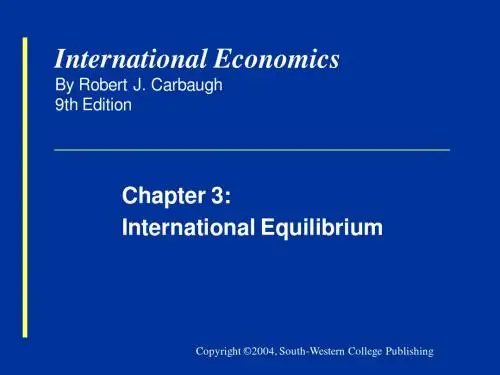
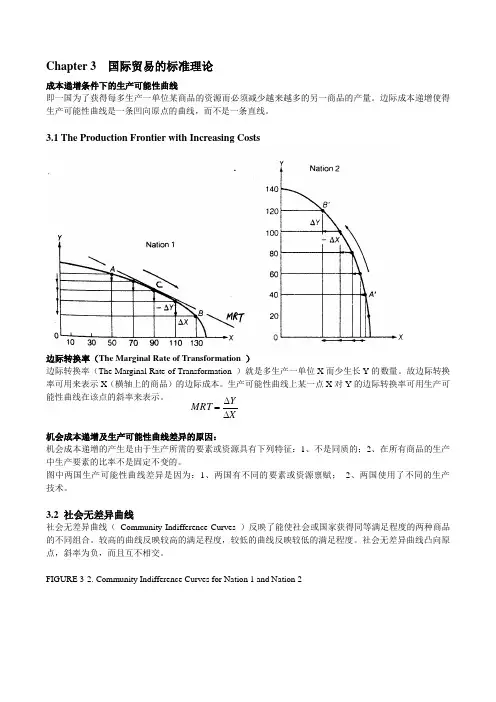
Chapter 3 国际贸易的标准理论成本递增条件下的生产可能性曲线即一国为了获得每多生产一单位某商品的资源而必须减少越来越多的另一商品的产量。
边际成本递增使得生产可能性曲线是一条凹向原点的曲线,而不是一条直线。
3.1 The Production Frontier with Increasing Costs边际转换率(The Marginal Rate of Transformation )边际转换率(The Marginal Rate of Transformation )就是多生产一单位X 而少生长Y 的数量。
故边际转换率可用来表示X (横轴上的商品)的边际成本。
生产可能性曲线上某一点X 对Y 的边际转换率可用生产可能性曲线在该点的斜率来表示。
机会成本递增及生产可能性曲线差异的原因:机会成本递增的产生是由于生产所需的要素或资源具有下列特征:1、不是同质的;2、在所有商品的生产中生产要素的比率不是固定不变的。
图中两国生产可能性曲线差异是因为:1、两国有不同的要素或资源禀赋; 2、两国使用了不同的生产 技术。
3.2 社会无差异曲线社会无差异曲线( Community Indifference Curves )反映了能使社会或国家获得同等满足程度的两种商品的不同组合。
较高的曲线反映较高的满足程度,较低的曲线反映较低的满足程度。
社会无差异曲线凸向原点,斜率为负,而且互不相交。
FIGURE 3-2. Community Indifference Curves for Nation 1 and Nation 2X Y MRT ∆∆=边际替代率(The Marginal Rate of Substitution )边际替代率(The Marginal Rate of Substitution )指的是一国为保持在原来的无差异曲线上,多消费一单位X而必须放弃的Y的数量。
社会无差异曲线上某点X对Y的边际替代率用该点的斜率的绝对值表示,并且随着该国的消费组合沿该曲线下移而下降。
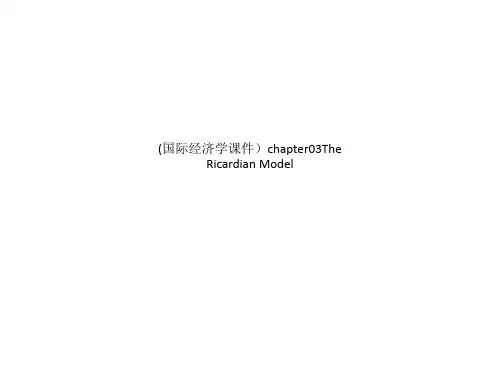
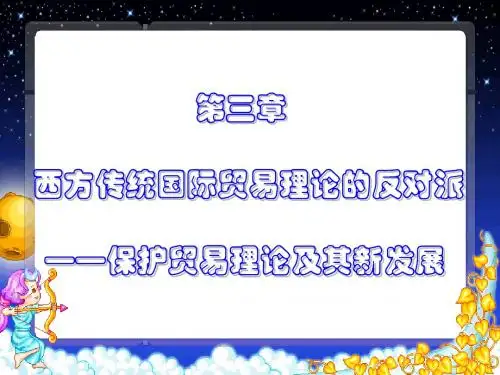
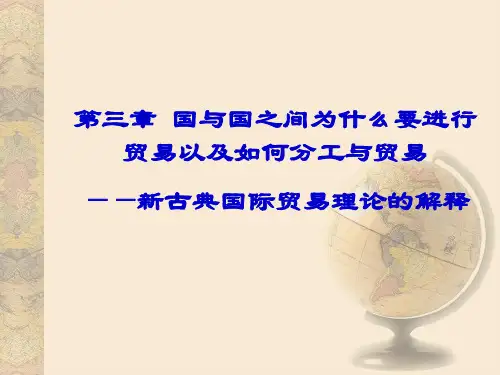
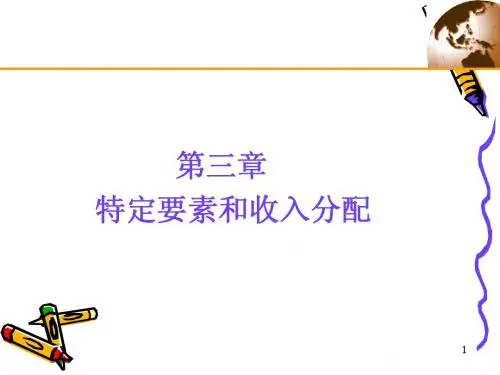
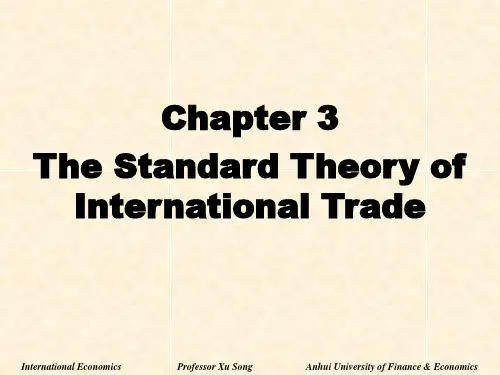
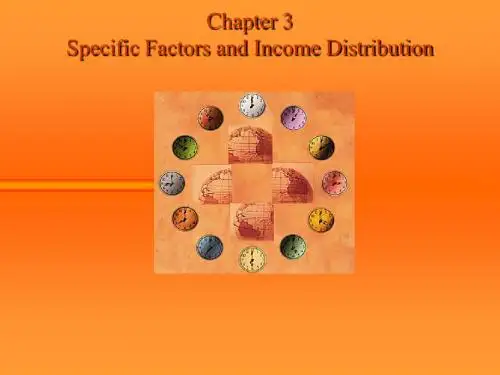
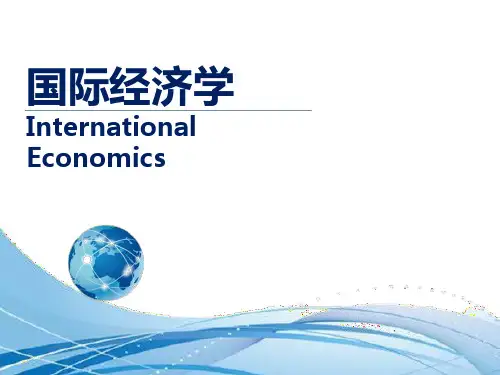
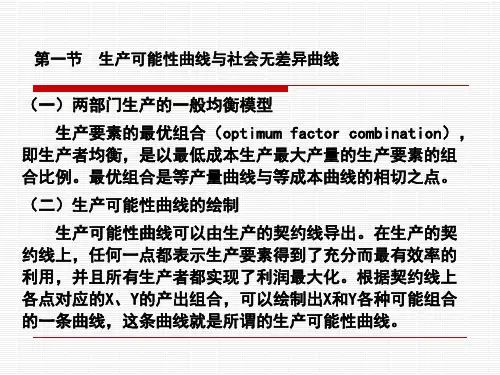
Chapter 3Labor Productivity and Comparative Advantage: The Ricardian ModelChina-US Trade at HS2 level in 2009PreviewOpportunity costs and comparative advantage A one factor Ricardian modelProduction possibilitiesGains from tradeWages and tradeMisconceptions about comparative advantage Transportation costs and non-traded goodsEmpirical evidenceIntroductionTheories of why trade occurs can be grouped into three categories:Market size and distance between markets determine how much countries buy and sell. These transactions benefit both buyers and sellers.Differences in labor, labor skills, physical capital, natural resources, and technology create productive advantages for countries.Economies of scale (a larger scale is more efficient) create productive advantages for countries.Introduction (cont.)The Ricardian model (chapter 3) says differences in the productivity of labor between countries cause productive differences, leading to gains from trade.•Differences in productivity are usually explained by differences in technology.The Heckscher-Ohlin model (chapter 4) says differences in labor, labor skills, physical capital, land, or other factors of production between countries cause productive differences, leading to gains from trade.and Opportunity CostThe Ricardian model uses the concepts of opportunity cost and comparative advantage.The opportunity cost of producing something measures the cost of not being able to produce something else because resources have already been used.and Opportunity Cost (cont.)A country faces opportunity costs when it employsresources to produce goods and services.For example, a limited number of workers could be employed to produce either roses or computers.•The opportunity cost of producing computers is the amount of roses not produced.•The opportunity cost of producing roses is the amount of computers not produced.• A country faces a trade off: how many computers or roses should it produce with the limited resources that it has?and Opportunity Cost (cont.)Suppose that in the U.S. 10 million roses could be produced with the same resources that could produce100,000 computers.Suppose that in China 10 million roses could be produced with the same resources that could produce 30,000computers.Workers in China would be less productive than those in the U.S. in manufacturing computers.Quick quiz: what is the opportunity cost for China if it decides to produce roses?and Opportunity Cost (cont.)China has a lower opportunity cost of producing roses.•China can produce 10 million roses, compared to30,000 computers that it could otherwise produce.•The US can produce 10 million roses, compared to100,000 computers that it could otherwise produce.and Opportunity Cost (cont.)The US has a lower opportunity cost of producing computers.•China can produce 30,000 computers, compared to 10 million roses that it could otherwise produce.•The US can produce 100,000 computers, compared to10 million roses that it could otherwise produce.•The US can produce 30,000 computers, compared to3.3 million roses that it could otherwise produce.and Opportunity Cost (cont.)A country has a comparative advantage in producing a good if the opportunity cost of producing that good is lower in the country than it is in other countries.A country with a comparative advantage in producing a good uses its resources most efficiently when it produces that good compared to producing other goods.and Opportunity Cost (cont.)The U.S. has a comparative advantage in computer production: it uses its resources more efficiently inproducing computers compared to other uses.China has a comparative advantage in rose production: it uses its resources more efficiently in producing rosescompared to other uses.Suppose initially that China produces computers and the U.S. produces roses, and that both countries want toconsume computers and roses.Can both countries be made better off?Comparative Advantage andTradeMillions of Roses Thousands ofComputersU.S.-10+100 China+10-30 Total0+70Comparative Advantage and Trade(cont.)In this simple example, we see that when countries specialize in production in which they have a comparative advantage, more goods and services can be produced and consumed.•Initially both countries could only consume 10 million roses and30 thousand computers.•If they produce goods in which they had a comparative advantage, they could still consume 10 million roses, but could consume100,000 –30,000 = 70,000 more computers.A One Factor Ricardian Model The simple example with roses and computers explains the intuition behind the Ricardian model. We formalize these ideas by constructing a slightly more complex one factor Ricardian model using the following simplifying assumptions:A One Factor Ricardian Model(cont.)bor services are the only resourceimportant for production.bor productivity varies across countries,usually due to differences in technology,but labor productivity in each country isconstant across time.3.The supply of labor services in eachcountry is constant.A One Factor Ricardian Model (cont.)4.Only two goods are important for productionand consumption: wine and cheese.petition allows workers to be paid a“competitive”wage, a function of theirproductivity and the price of the good that theycan sell, and allows them to work in theindustry that pays the highest wage.6.Only two countries are modeled: domestic andforeign.(cont.)Because labor productivity is constant, define a unit labor requirement as the constant number of hours of laborrequired to produce one unit of output.•aLW is the unit labor requirement for wine in the domestic country.For example, if aLW = 2, then it takes 2 hours of labor to produceone liter of wine in the domestic country.•aLC is the unit labor requirement for cheese in the domestic country.For example, if aLC = 1, then it takes 1 hour of labor to produce onekg of cheese in the domestic country.• A high unit labor requirement means low labor productivity.(cont.)Because the supply of labor is constant, denote the total number of labor hours worked in the domestic country as a constant number L.Production PossibilitiesThe production possibility frontier(PPF) of an economy shows the maximum amount of a goods that can be produced fora fixed amount of resources.If QC represents the quantity of cheese produced and QWrepresents the quantity of wine produced, then the production possibility frontier of the domestic economy has the equation:a LC QC+ aLWQW= LTotal unitsof wineproductionLabor required for each unit of cheese production Total unitsof cheeseproductionLabor required foreach unit of wineproductionTotal amount oflabor resourcesFig. 3-1: Home’s Production Possibility FrontierProduction Possibilities (cont.)a LC Q C + a LW Q W = LQ C = L/a LC when Q W = 0Q W = L/a LW when Q C = 0Q W = L/a LW –(a LC /a LW )Q C : the equation for the PPF, with a slope equal to –(a LC /a LW )Production Possibilities (cont.) When the economy uses all of its resources, the opportunity cost of cheese production is the quantity of wine that is given up (reduced) as Q C increases: (a LC/a LW)When the economy uses all of its resources, the opportunity cost is equal to the absolute value of the slope of the PPF, and it is constant when unit labor requirements are constant.Production Possibilities (cont.) To produce an additional kg of cheesehours of work.requires aLCEach hour devoted to cheese production could have been used to produce a certain amount of wine instead, equal to1 hour/(ahours/liter of wine)LW) liter of wine= (1/aLWProduction Possibilities (cont.) For example, if 1 hour is moved to cheese production, that additional hour of labor could have produced 1 hour/(2 hours/liter of wine) = 1/2 liter of wine.The trade-off is the increased amount of cheese relative to the decreased amount ofwine: aLC /aLW.Production Possibilities (cont.) In general, the amount of the domestic economy’s production is defined bya LC Q C+ a LW Q W≤LThis describes what an economy canproduce, but to determine what the economy does produce, we must determine the prices of goods.Production, Prices and Wages Let P C be the price of cheese and P W be the price of wine.Because of competition,•hourly wages of cheese makers are equal to the market value of the cheese produced in an hour: P C /a LC•hourly wages of wine makers are equal to the market value of the wine produced in an hour: P W /a LWBecause workers like high wages, they will work in the industry that pays a higher hourly wage.(cont.)If P C /a LC > P W /a LW workers will make only cheese.•If P C /P W > a LC /a LW workers will only make cheese.•The economy will specialize in cheese production if theprice of cheese relative to the price of wine exceeds the opportunity cost of producing cheese.If P C /a LC < P W /a LW workers will make only wine.•If P C /P W < a LC /a LW workers will only make wine.•If P W /P C > a LW /a LC workers will only make wine.•The economy will specialize in wine production if the price of wine relative to the price of cheese exceeds the opportunity cost of producing wine.(cont.)If the domestic country wants to consume both wine and cheese (in the absence of international trade), relative prices must adjust so that wages are equal in the wine and cheese industries.•If P C /a LC = P W /a LW workers will have no incentive to work solely in the cheese industry or the wine industry, so that production of both goods can occur.•P C /P W = a LC /a LW•Production (and consumption) of both goods occurs when the relative price of a good equals the opportunity cost of producing that good.Trade in the Ricardian Model Suppose that the domestic country has a comparative advantage in cheese production: its opportunity cost of producing cheese is lower than it is in the foreign country.a LC /a LW < a *LC /a *LW•where “*”notates foreign country variablesWhen the domestic country increases cheese production, it reduces wine production less than the foreign country would because the domestic unit labor requirement of cheese production is low compared to that of wine production.(cont.)Suppose the domestic country is more efficient in wine and cheese production.It has an absolute advantage in all production: its unit labor requirements for wine and cheese production are lower than those in the foreign country:•aLC < a*LCand aLW< a*LWA country can be more efficient in producing bothgoods, but it will have a comparative advantage in only one good—the good that uses resources most efficiently compared to alternative production.(cont.)Even if a country is the most (or least) efficient producer of all goods, it still can benefit from trade.To see how all countries can benefit from trade, we calculate relative prices when trade exists.•Without trade, the relative price of a good equals the opportunity cost of producing that good.To calculate relative prices with trade, we first calculate relative quantities of world production:(QC + Q*C)/(QW+ Q*W)Relative Supply and RelativeDemandNext we consider relative supply of cheese: the quantity of cheese supplied by all countries relative to the quantity of wine supplied by all countries at each price of cheese relative to the price of wine, P c /P W.Relative Supply and RelativeDemand (cont.)a LC /a LWa *LC /a *LW RSRelative priceof cheese, P C /P WRelative quantity of cheese, Q C + Q *C Q W + Q *W L/a LC L */a *LWRelative Supply and Relative Demand(cont.)There is no supply of cheese if the relative price of cheese falls below a LC /a LW .•Why? because the domestic country will specialize in wine production whenever P C /P W < a LC /a LW•And we assumed that a LC /a LW < a *LC /a *LW so foreign workers won’t find it desirable to produce cheese either.When P C /P W =a LC /a LW , domestic workers will beindifferent between producing wine or cheese, but foreign workers will still produce only wine.Relative Supply and Relative Demand(cont.)When a*LC /a*LW> Pc/PW>aLC/aLW, domestic workersspecialize in cheese production because they can earn higher wages, but foreign workers will still produce only wine.When a*LC /a*LW= PC/PW, foreign workers will beindifferent between producing wine or cheese, butdomestic workers will still produce only cheese.There is no supply of wine if the relative price of cheeserises above a*LC /a*LWRelative Supply and Relative Demand(cont.)Relative demand of cheese is the quantity of cheese demanded in all countries relative to the quantity of wine demanded in all countries at each price of cheese relative to the price of wine, P C /P W. As the price of cheese relative to the price of wine rises, consumers in all countries will tend to purchase less cheese and more wine sothat the relative quantity of cheese demanded falls.Relative Supply and RelativeDemand (cont.)RD1a LC /a LW a *LC /a *LWRSRelative priceof cheese, P C /P WRelative quantity of cheese, Q C + Q *C Q W + Q *WL/a LC L */a *LWFig. 3-3: World Relative Supplyand DemandGains From TradeGains from trade come from specializing in the type of production which uses resources most efficiently, andusing the income generated from that production to buy the goods and services that countries desire.•where “using resources most efficiently”means producing a good in which a country has a comparative advantage.Domestic workers earn a higher income from cheese production because the relative price of cheese increases with trade.Gains From Trade (cont.)Foreign workers earn a higher income from wine production because the relative price of cheese decreases with trade (making cheese cheaper) andthe relative price of wine increases with trade.Gains From Trade (cont.)Think of trade as an indirect method of production or a new technology that converts cheese into wine or vice versa.Without the technology, a country has to allocate resources to produce all of the goods that it wants to consume.With the technology, a country can specialize its production and trade (“convert”) the products for the goods that it wantsto consume.Gains From Trade (cont.)We show how consumption possibilities expand beyond the production possibility frontier when trade is allowed.Without trade, consumption is restricted to what is produced.With trade, consumption in each country is expanded because world production is expanded when each country specializes in producing the good in which it has a comparative advantage.Fig. 3-4: Trade Expands Consumption PossibilitiesA Numerical Examplea LC /a LW = 1/2 < a *LC /a *LW = 2Unit labor requirements for domestic and foreigncountriesCheese WineDomestica LC = 1 hour/kg a LW = 2 hours/L Foreign a *LC = 6 hours/kga *LC = 3 hours/LA Numerical Example (cont.)The domestic country is more efficient in both industries, but it has a comparative advantage only in cheese production.The foreign country is less efficient in bothindustries, but it has a comparative advantage in wine production.Quick quiz: what is the domestic country’sopportunity cost of producing wine? what is its opportunity cost of producing cheese?A Numerical Example (cont.)With trade, the equilibrium relative price of cheese must be between a LC/a LW= 1/2 and a*LC /a*LW= 2 Suppose that P/P W= 1 in equilibrium.C•In words, one kg of cheese trades for one liter of wine.A Numerical Example (cont.) If the domestic country does not trade, it can use one hour of labor toproduce 1/aLW= 1/2 liter of wine.If the domestic country does trade, it can use one hour of labor toproduce 1/aLC = 1 kg of cheese, sell this amount to the foreign countryat current prices to obtain 1 liter of wine.If the foreign country does not trade, it can use one hour of labor to produce 1/a*LC= 1/6 kg of cheese.If the foreign country does trade, it can use one hour of labor toproduce 1/a*LW = 1/3 liter of wine, sell this amount to the domesticcountry at current prices to obtain 1/3 kg of cheese.General Equilibrium under FreeTradeSee notes!Relative CN-US wage:1985~2008China/US Wage Ratio0.005.0010.0015.00198519861987198819891990199119921993199419951996199719981999200020012002200320042005200620072008Year P e r c e n t China/US Wage Ratio。